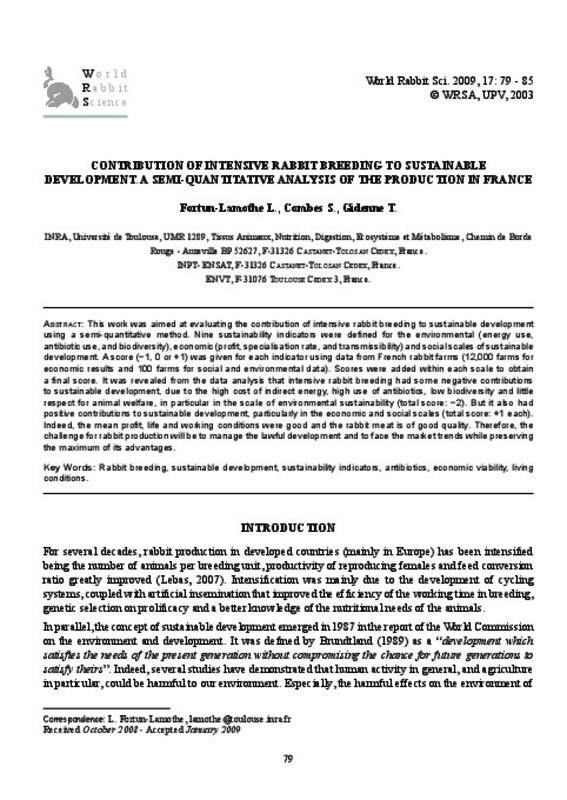JavaScript is disabled for your browser. Some features of this site may not work without it.
Buscar en RiuNet
Listar
Mi cuenta
Estadísticas
Ayuda RiuNet
Admin. UPV
Contribution of intensive rabbit breeding to sustainable development. A semi-quantitative analysis of the production in France
Mostrar el registro sencillo del ítem
Ficheros en el ítem
| dc.contributor.author | Fortun-Lamothe, L.
|
|
| dc.contributor.author | Combes, S.
|
|
| dc.contributor.author | Gidenne, T.
|
|
| dc.date.accessioned | 2009-07-27T11:44:14Z | |
| dc.date.available | 2009-07-27T11:44:14Z | |
| dc.date.issued | 2009 | |
| dc.identifier.issn | 1257-5011 | |
| dc.identifier.uri | http://hdl.handle.net/10251/6043 | |
| dc.description.abstract | [EN] This work was aimed at evaluating the contribution of intensive rabbit breeding to sustainable development using a semi-quantitative method. Nine sustainability indicators were defined for the environmental (energy use, antibiotic use, and biodiversity), economic (profit, specialisation rate, and transmissibility) and social scales of sustainable development. A score (-1, 0 or +1) was given for each indicator using data from French rabbit farms (12,000 farms for economic results and 100 farms for social and environmental data). Scores were added within each scale to obtain a final score. It was revealed from the data analysis that intensive rabbit breeding had some negative contributions to sustainable development, due to the high cost of indirect energy, high use of antibiotics, low biodiversity and little respect for animal welfare, in particular in the scale of environmental sustainability (total score: -2). But it also had positive contributions to sustainable development, particularly in the economic and social scales (total score: +1 each). Indeed, the mean profit, life and working conditions were good and the rabbit meat is of good quality. Therefore, the challenge for rabbit production will be to manage the lawful development and to face the market trends while preserving the maximum of its advantages | en_EN |
| dc.language | Inglés | en_EN |
| dc.publisher | World Rabbit Science. ICTA. UPV | en_EN |
| dc.relation.ispartof | World Rabbit Science | |
| dc.rights | Reserva de todos los derechos | es_ES |
| dc.subject | Living conditions | en_EN |
| dc.subject | Economic viability | en_EN |
| dc.subject | Antibiotics | en_EN |
| dc.subject | Sustainability indicators | en_EN |
| dc.subject | Sustainable development | en_EN |
| dc.subject | Rabbit breeding | en_EN |
| dc.title | Contribution of intensive rabbit breeding to sustainable development. A semi-quantitative analysis of the production in France | en_EN |
| dc.type | Artículo | en_EN |
| dc.identifier.doi | 10.4995/wrs.2009.661 | |
| dc.rights.accessRights | Abierto | es_ES |
| dc.description.bibliographicCitation | Fortun-Lamothe, L.; Combes, S.; Gidenne, T. (2009). Contribution of intensive rabbit breeding to sustainable development. A semi-quantitative analysis of the production in France. World Rabbit Science. 17(2):79-85. https://doi.org/10.4995/wrs.2009.661 | es_ES |
| dc.relation.publisherversion | https://doi.org/10.4995/wrs.2009.661 | |
| dc.description.upvformatpinicio | 79 | |
| dc.description.upvformatpfin | 85 | |
| dc.description.volume | 17 | |
| dc.description.issue | 2 | |
| dc.identifier.eissn | 1989-8886 | es_ES |








